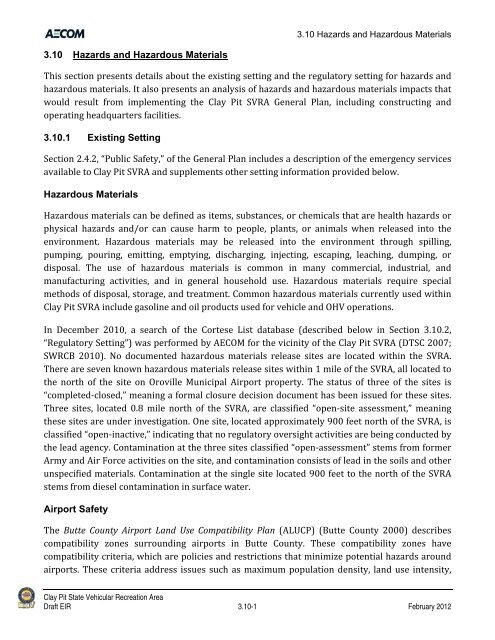Draft Environmental Impact Report - California Off Highway Vehicle ...
Draft Environmental Impact Report - California Off Highway Vehicle ...
Draft Environmental Impact Report - California Off Highway Vehicle ...
You also want an ePaper? Increase the reach of your titles
YUMPU automatically turns print PDFs into web optimized ePapers that Google loves.
3.10 Hazards and Hazardous Materials<br />
3.10 Hazards and Hazardous Materials<br />
This section presents details about the existing setting and the regulatory setting for hazards and<br />
hazardous materials. It also presents an analysis of hazards and hazardous materials impacts that<br />
would result from implementing the Clay Pit SVRA General Plan, including constructing and<br />
operating headquarters facilities.<br />
3.10.1 Existing Setting<br />
Section 2.4.2, “Public Safety,” of the General Plan includes a description of the emergency services<br />
available to Clay Pit SVRA and supplements other setting information provided below.<br />
Hazardous Materials<br />
Hazardous materials can be defined as items, substances, or chemicals that are health hazards or<br />
physical hazards and/or can cause harm to people, plants, or animals when released into the<br />
environment. Hazardous materials may be released into the environment through spilling,<br />
pumping, pouring, emitting, emptying, discharging, injecting, escaping, leaching, dumping, or<br />
disposal. The use of hazardous materials is common in many commercial, industrial, and<br />
manufacturing activities, and in general household use. Hazardous materials require special<br />
methods of disposal, storage, and treatment. Common hazardous materials currently used within<br />
Clay Pit SVRA include gasoline and oil products used for vehicle and OHV operations.<br />
In December 2010, a search of the Cortese List database (described below in Section 3.10.2,<br />
“Regulatory Setting”) was performed by AECOM for the vicinity of the Clay Pit SVRA (DTSC 2007;<br />
SWRCB 2010). No documented hazardous materials release sites are located within the SVRA.<br />
There are seven known hazardous materials release sites within 1 mile of the SVRA, all located to<br />
the north of the site on Oroville Municipal Airport property. The status of three of the sites is<br />
“completed‐closed,” meaning a formal closure decision document has been issued for these sites.<br />
Three sites, located 0.8 mile north of the SVRA, are classified “open‐site assessment,” meaning<br />
these sites are under investigation. One site, located approximately 900 feet north of the SVRA, is<br />
classified “open‐inactive,” indicating that no regulatory oversight activities are being conducted by<br />
the lead agency. Contamination at the three sites classified “open‐assessment” stems from former<br />
Army and Air Force activities on the site, and contamination consists of lead in the soils and other<br />
unspecified materials. Contamination at the single site located 900 feet to the north of the SVRA<br />
stems from diesel contamination in surface water.<br />
Airport Safety<br />
The Butte County Airport Land Use Compatibility Plan (ALUCP) (Butte County 2000) describes<br />
compatibility zones surrounding airports in Butte County. These compatibility zones have<br />
compatibility criteria, which are policies and restrictions that minimize potential hazards around<br />
airports. These criteria address issues such as maximum population density, land use intensity,<br />
Clay Pit State Vehicular Recreation Area<br />
<strong>Draft</strong> EIR 3.10-1 February 2012








